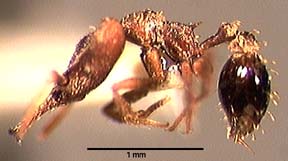
Specimen: Costa Rica, Prov. Alajuela: Rio Penas Blancas, 800m (J. Longino 1578-s). INBIOCRI001283785. Image by J. Longino.

Specimen: Costa Rica, Prov. Alajuela: Rio Penas Blancas, 800m (J. Longino 1578-s). INBIOCRI001283785. Image by J. Longino.
This manuscript name is a conditional proposal by B. Bolton (sensu Article 15 of the 1985 ICZN), and thus not made available here. Its appearance here or in any duplication of this page does not constitute publication (sensu Article 8 of the 1985 ICZN).
Dacetini, Myrmicinae, Formicidae, Hymenoptera, Insecta, Arthropoda, Animalia
John T. Longino, The Evergreen State College, Olympia WA 98505 USA. longinoj@evergreen.edu
25 July 1997
Specimen: Costa Rica, Prov. Alajuela: Rio Penas Blancas, 800m (J. Longino 1578-s). INBIOCRI001283785. Image by J. Longino. |
Specimen: Costa Rica, Prov. Alajuela: Rio Penas Blancas, 800m (J. Longino 1578-s). INBIOCRI001283785. Image by J. Longino. |
Identification
Face strongly flattened, margined laterally, and concave on vertex lobes; apical fork of mandible with one intercalary tooth; mandible with one preapical tooth near apical fork; gaster with strongly spatulate setae.
Head length 0.831mm, mandible length 0.480, head width 0.790, CI 95, MI 58 (n=1).
Range
Costa Rica (Atlantic slope).
Natural History
Brown and Wilson (1959) summarize the genus as follows:
"Widespread in tropics and warm temperate areas. Primarily forest-dwelling; some species occur in grassland and arid scrub. ... Nests mostly in soil and rotting wood; a few species live in arboreal plant cavities in tropical rain forest. Foraging hypogaeic to epigaeic-arboreal. Food: most species are collembolan feeders; a few are polyphagous predators or occasionally feed on sugary substances..."
platyscapa occurs in wet forest habitat, in leaf litter on the forest floor.
Selected Records
Winkler samples from Hitoy Cerere, Penas Blancas Valley.
Literature Cited
Brown, W. L., Jr., Wilson, E. O. 1959. The evolution of the dacetine ants. Quarterly Review of Biology 34:278-294.